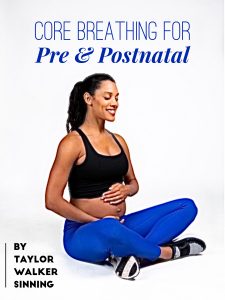Core Breathing for Pre & Postnatal

By Taylor Walker Sinning
The breath is the foundation of our lives and can help prenatal and postpartum women in so many ways. Your breath helps the mother get through tough times and increase your baby’s oxygen supply en utero. The breath helps us reconnect to our bodies postpartum and can help us gently strengthen our core after nine months of housing a baby. Often however, the pregnant mama may find herself without proper core function and as her belly grows to welcome her beautiful baby, lower back and pelvic issues arise and diastasis recti (abdominal separation) may occurdue to lack of that function and minimal internal support.
So what can be done?
We can begin by accessing the inner unit muscles: the transverse abdominus, internal obliques and their connection to the pelvic floor. But first, we need to figure out if you are a chest or a belly breather. Begin by placing one hand on your chest and the other one on your belly. Take a few natural inhalations and exhalations. Then take notice of which hand is moving. The goal is to get the hand on the belly to move. You also want to make sure the ribcage expands outward. This ensures that your diaphragm is doing the work.
Now, I want you to take a moment and picture your core belly pump as a soda can. The top of the can is your diaphragm. As you inhale, your ribs should expand laterally, and your belly should fill like a balloon. Upon exhale, your TVA and inner units should activate and draw in and wrap to the midline of your body. Picture squeezing an aluminum can until the two sides touch. To finish, the bottom of the can known as the pelvic floor lifts. You want to feel like you are trying to draw a marble or a blueberry in and upward in the vagina, without contracting the glutes.
It sounds much more complicated than it is, but once you have the core breathing down, you can successfully connect the dots to the functional movements you perform every day. Motherhood is hard work. We lift and lower strollers, carry car seats into and out of the house and take our bundles with us everywhere. Your core is a system that is a major stabilizerwithin the body and one that should not be ignored.
Try this core breathing series as often as possible to begin to train the inner unit to work and function with you throughout your workouts and daily activity.
Perform Each Breathing Position For 1 Minute
Then Relax for 30 Seconds
Repeat the series 3 times
Seated Core Breathing: Sit on a chair or on the floor. Inhale and expand your ribs and belly while your pelvic floor releases. As you exhale make a SHHHH sound. Finish the breath with a lift and hold of the pelvic floor for three seconds. Then release and reset. Feel your pelvic floor relax or “sink” fully before your next inhale.
Cat/Cow: With your hands underneath your shoulders and knees under your hips inhale as you look to the sky. Release the pelvic floor and expand belly and ribs. Begin your exhale as your curl the chin to chest, round your shoulders and pull baby to spine or think about engaging a corset and wrapping the belly. Finish by lifting the pelvic floor. Hold for 3 seconds and release.
Glute Bridge:
Lay on your back. If you are after 20 weeks and find yourself lightheaded in this position, roll over on your left side before coming to a seated position. You can also place a pillow or blanket under your shoulders and head to keep your head above your heart.
Lay down with your feet hip distance apart and plant your feet firmly on the ground. Inhale and expand belly and ribs. Begin your exhale, press your heels into the ground, lift your hips so that your knees, hips, and shoulders make one straight line. Activate your TVA or your inner corset and finish by lifting your pelvic floor. Lower your hips and repeat.
